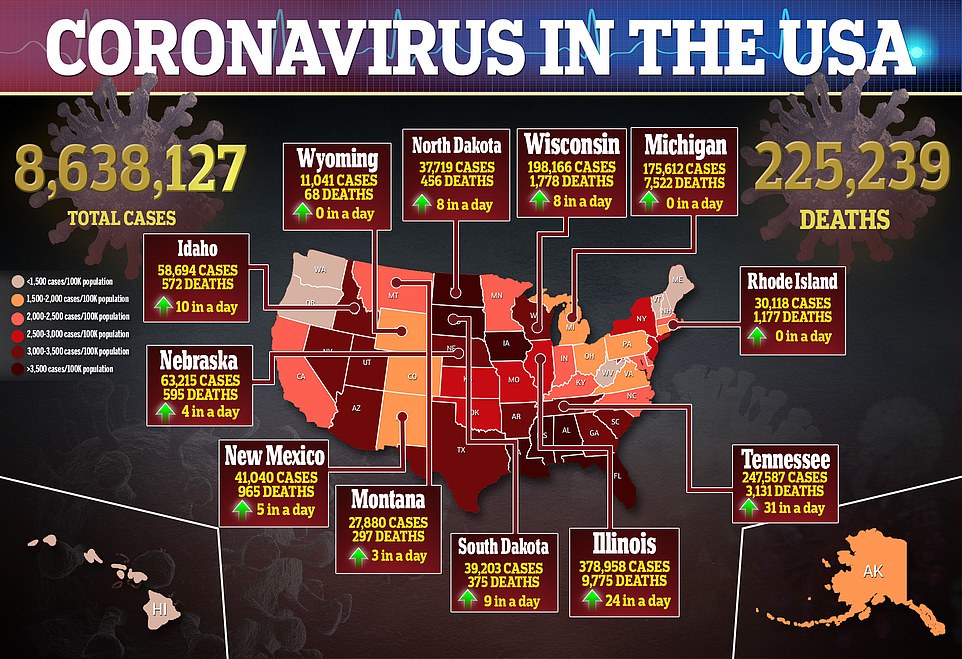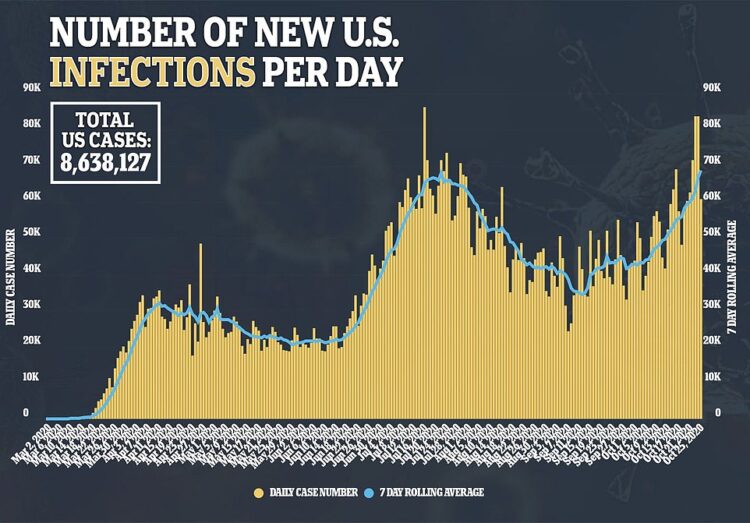The US has set a record for new coronavirus cases reported in a single week with more than 481,300 infections, as the virus continues to surge across the Midwest and the South.
The seven-day moving average of new daily cases stood at 68,767 after Sunday – the highest peak since late July and a 5.9 percent increase from the week before, according to the COVID Tracking Project.
A total of 481,372 new cases were added to the nation’s case count of more than 8.63 million between October 19 and 25 – a period which included two record-high days for new cases on Friday and Saturday, both exceeding 80,000.
On Sunday 60,789 new cases were reported, representing the highest number on a Sunday since July 22.
Hospitalizations have also been rising across the country with more than 41,753 people admitted as of Sunday – up from 36,428 the Sunday before.
The seven-day average number of daily deaths hit 807 in the week ended Sunday – the highest its been since mid-September but down 70 percent from the peak seven-day average of 2,715 in April.
In the last week 5,633 new deaths were reported, for a total of 225,239 since the outbreak began.
The highest rates of new infections have come from Southern and Midwestern states, which accounted for 66 percent of daily new cases and 74 percent of hospitalizations in the week ended Sunday.
El Paso County in Texas took the drastic step to impose a curfew between 10pm and 5am on Sunday as cases skyrocketed and hospitals reached 100 percent capacity.
Meanwhile hospitalizations in California have dropped precipitously in the month since officials predicted that the state would see an 89 percent increase in hospitalized patients.
Dire predictions that the virus spread will further accelerate in the cold winter months have once again cast a harsh spotlight on President Trump’s handling of the pandemic as Election Day approaches next week.
Twenty-eight states have reported their daily record high of COVID-19 cases in the month of October alone, fueling fears that the pandemic is accelerating anew as cooler weather takes hold in many parts of the country.
Seven states – Indiana, North Dakota, Montana, Oklahoma, Utah and Ohio – posted record single-day increases in new infections on Thursday, followed by records in 16 states on Friday.
On Wednesday the US saw its highest number of coronavirus deaths in two months with 1,124. Increases in deaths tend to trail spikes new infections by several weeks.
A report released last week by Columbia University estimated that between 130,000 and 210,000 COVID-19 deaths could have been avoided in the US, calling the federal government’s response to the pandemic an ‘enormous failure’.
‘The weight of this enormous failure ultimately falls to the leadership at the White House – and among a number of state governments – which consistently undercut the efforts of top officials at the CDC and HHS,’ the report said, referring to the US Centers for Disease Control and Prevention and the Department of Health and Human Services.
Along with spikes in cases and deaths, the number of COVID-19 patients in US hospitals climbed to a two-month high in the past week with over 41,000 people hospitalized as of Sunday – up nearly 36 percent from October 1.
California managed to avoid the national trend of rising hospitalizations in recent weeks despite having warned in late September that hospitalizations could increase by 80 percent within the next month.
The state’s Health and Human Services Secretary Dr Mark Ghaly told the Los Angeles Times on September 25 that California was on track to have more than 4,800 people hospitalized by October 25.
When that date came on Sunday, the state reported having around 2,969 patients hospitalized – nearly 2,000 less than Dr Ghaly’s prediction.
That number is down significantly from late July, when more than 8,400 patients were hospitalized in California.
California saw a 3.5 percent increase in daily new cases in the week ended Sunday for a total of 30,712 in that period and a daily average of about 4,387.
To date, the state has reported a total of 898,029 cases and 17,345 deaths.
Officials in El Paso, Texas, announced that the county had reached ‘a crisis stage’ on Sunday afternoon as all of its hospitals and intensive care units reached capacity.
El Paso County Judge Ricardo Samaniego ordered a curfew that will remain in place for the next two weeks in response to alarming coronavirus trends.
Over the last three weeks, the number of hospitalized COVID-19 patients in the El Paso area has tripled from 259 to a record 786, according to state data. More than 170 of those patients remain in intensive care.
El Paso health officials announced 517 new cases of COVID-19 on Sunday, bringing the county’s total up to more than 39,920.
The total figure has skyrocketed from the fewer than 25,000 cases recorded at the beginning of the month.
Three new deaths were also reported Sunday, bringing up the county’s total for 593 since March.
During a coronavirus briefing in Illinois on Friday, the state’s top health official broke down in tears as she announced the latest tallies and pleaded with residents to remain vigilant in their efforts to slow the pandemic.
‘I want to say happy Friday, but I understand the mental, the social and the emotional toll that this pandemic continues to have on people,’ Illinois Department of Public Health Department Director Dr Ngozi Ezike said at the top of Friday’s virus briefing, her voice quaking with emotion.
‘Yesterday we lost an additional 31 lives, for a total of 9,418 deaths,’ she said. ‘These are people who started with us in 2020 and won’t be with us at the Thanksgiving table.’
Ezike then excused herself and turned away from the podium to wipe away tears before continuing her remarks.
She said that her position as health director does not keep her in ‘some Covid free bubble exempt from all the pain and the tragedy of this pandemic’.
‘I understand how pandemic fatigue is striking everyone. It’s real,’ she said.
‘People are tired of not seeing their families. They’re tired of postponing the weddings and the other life celebrations. Trying to work from home while also trying to manage kids learning remotely is a challenge.’
‘My message to you is to stay strong,’ she continued. ‘I’ve never run a marathon, but I have the utmost regard for those who’ve been able to train and plan and finish a marathon.
‘But this is a difficult race when you can’t actually see the endpoint and I’m sorry that that’s the message I have for you.’
In the face of spiking hospitalization rates nationwide, the Food and Drug Administration on Thursday formally approved Gilead Sciences Inc’s antiviral drug remdesivir for treating patients hospitalized with COVID-19.
The drug, which has been in wide use under an emergency authorization, is the first to be officially approved for the disease in the US.

